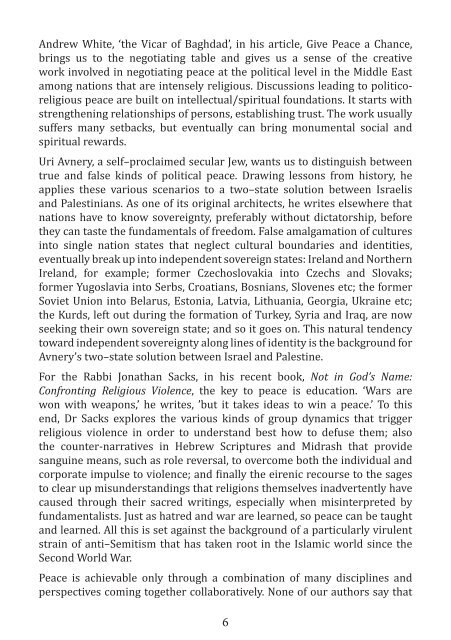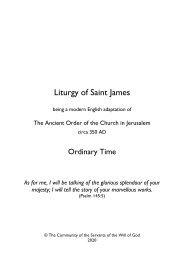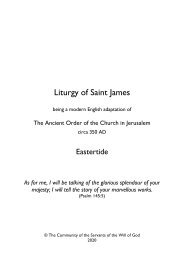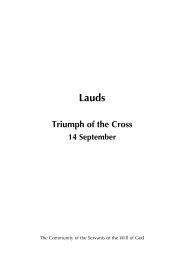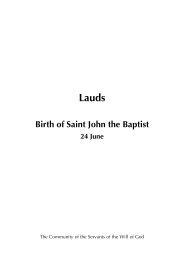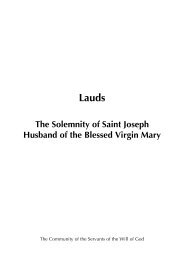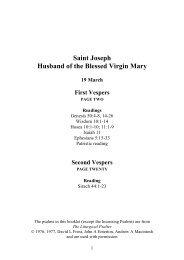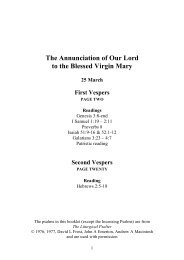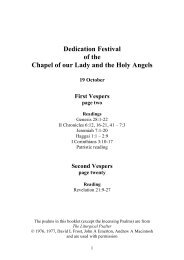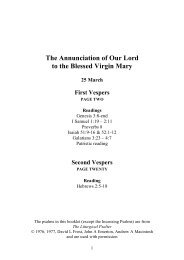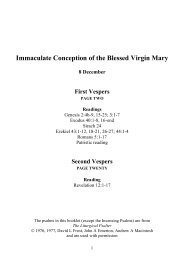Peace in the Face of War
You also want an ePaper? Increase the reach of your titles
YUMPU automatically turns print PDFs into web optimized ePapers that Google loves.
Andrew White, ‘<strong>the</strong> Vicar <strong>of</strong> Baghdad’, <strong>in</strong> his article, Give <strong>Peace</strong> a Chance,<br />
br<strong>in</strong>gs us to <strong>the</strong> negotiat<strong>in</strong>g table and gives us a sense <strong>of</strong> <strong>the</strong> creative<br />
work <strong>in</strong>volved <strong>in</strong> negotiat<strong>in</strong>g peace at <strong>the</strong> political level <strong>in</strong> <strong>the</strong> Middle East<br />
among nations that are <strong>in</strong>tensely religious. Discussions lead<strong>in</strong>g to politicoreligious<br />
peace are built on <strong>in</strong>tellectual/spiritual foundations. It starts with<br />
streng<strong>the</strong>n<strong>in</strong>g relationships <strong>of</strong> persons, establish<strong>in</strong>g trust. The work usually<br />
suffers many setbacks, but eventually can br<strong>in</strong>g monumental social and<br />
spiritual rewards.<br />
Uri Avnery, a self–proclaimed secular Jew, wants us to dist<strong>in</strong>guish between<br />
true and false k<strong>in</strong>ds <strong>of</strong> political peace. Draw<strong>in</strong>g lessons from history, he<br />
applies <strong>the</strong>se various scenarios to a two–state solution between Israelis<br />
and Palest<strong>in</strong>ians. As one <strong>of</strong> its orig<strong>in</strong>al architects, he writes elsewhere that<br />
nations have to know sovereignty, preferably without dictatorship, before<br />
<strong>the</strong>y can taste <strong>the</strong> fundamentals <strong>of</strong> freedom. False amalgamation <strong>of</strong> cultures<br />
<strong>in</strong>to s<strong>in</strong>gle nation states that neglect cultural boundaries and identities,<br />
eventually break up <strong>in</strong>to <strong>in</strong>dependent sovereign states: Ireland and Nor<strong>the</strong>rn<br />
Ireland, for example; former Czechoslovakia <strong>in</strong>to Czechs and Slovaks;<br />
former Yugoslavia <strong>in</strong>to Serbs, Croatians, Bosnians, Slovenes etc; <strong>the</strong> former<br />
Soviet Union <strong>in</strong>to Belarus, Estonia, Latvia, Lithuania, Georgia, Ukra<strong>in</strong>e etc;<br />
<strong>the</strong> Kurds, left out dur<strong>in</strong>g <strong>the</strong> formation <strong>of</strong> Turkey, Syria and Iraq, are now<br />
seek<strong>in</strong>g <strong>the</strong>ir own sovereign state; and so it goes on. This natural tendency<br />
toward <strong>in</strong>dependent sovereignty along l<strong>in</strong>es <strong>of</strong> identity is <strong>the</strong> background for<br />
Avnery’s two–state solution between Israel and Palest<strong>in</strong>e.<br />
For <strong>the</strong> Rabbi Jonathan Sacks, <strong>in</strong> his recent book, Not <strong>in</strong> God’s Name:<br />
Confront<strong>in</strong>g Religious Violence, <strong>the</strong> key to peace is education. ‘<strong>War</strong>s are<br />
won with weapons,’ he writes, ’but it takes ideas to w<strong>in</strong> a peace.’ To this<br />
end, Dr Sacks explores <strong>the</strong> various k<strong>in</strong>ds <strong>of</strong> group dynamics that trigger<br />
religious violence <strong>in</strong> order to understand best how to defuse <strong>the</strong>m; also<br />
<strong>the</strong> counter-narratives <strong>in</strong> Hebrew Scriptures and Midrash that provide<br />
sangu<strong>in</strong>e means, such as role reversal, to overcome both <strong>the</strong> <strong>in</strong>dividual and<br />
corporate impulse to violence; and f<strong>in</strong>ally <strong>the</strong> eirenic recourse to <strong>the</strong> sages<br />
to clear up misunderstand<strong>in</strong>gs that religions <strong>the</strong>mselves <strong>in</strong>advertently have<br />
caused through <strong>the</strong>ir sacred writ<strong>in</strong>gs, especially when mis<strong>in</strong>terpreted by<br />
fundamentalists. Just as hatred and war are learned, so peace can be taught<br />
and learned. All this is set aga<strong>in</strong>st <strong>the</strong> background <strong>of</strong> a particularly virulent<br />
stra<strong>in</strong> <strong>of</strong> anti–Semitism that has taken root <strong>in</strong> <strong>the</strong> Islamic world s<strong>in</strong>ce <strong>the</strong><br />
Second World <strong>War</strong>.<br />
<strong>Peace</strong> is achievable only through a comb<strong>in</strong>ation <strong>of</strong> many discipl<strong>in</strong>es and<br />
perspectives com<strong>in</strong>g toge<strong>the</strong>r collaboratively. None <strong>of</strong> our authors say that<br />
6


